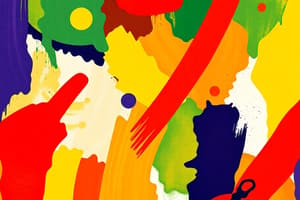Podcast
Questions and Answers
What aspect of color refers to the difference between two colors in terms of hue, saturation, and brightness?
What aspect of color refers to the difference between two colors in terms of hue, saturation, and brightness?
- Color Psychology
- Color Harmony
- Complementary Colors
- Contrast (correct)
Which type of color arrangement creates a pleasing visual effect by combining colors effectively?
Which type of color arrangement creates a pleasing visual effect by combining colors effectively?
- Complementary Colors
- Triadic Colors
- Analogous Colors (correct)
- Primary Colors
What study examines how colors can influence human behavior and emotions?
What study examines how colors can influence human behavior and emotions?
- Contrast Theory
- Color Psychology (correct)
- Color Harmony Study
- Saturation Analysis
Which pair of colors can create an 'opposite' effect when combined?
Which pair of colors can create an 'opposite' effect when combined?
Why is effective contrast important in design?
Why is effective contrast important in design?
How can color psychology be beneficial in design?
How can color psychology be beneficial in design?
What is the primary purpose of understanding color theory?
What is the primary purpose of understanding color theory?
What is the definition of hue according to the passage?
What is the definition of hue according to the passage?
How does the passage describe the relationship between saturation and color intensity?
How does the passage describe the relationship between saturation and color intensity?
What is the primary purpose of understanding brightness in color theory?
What is the primary purpose of understanding brightness in color theory?
Which of the following is not an aspect of color theory discussed in the passage?
Which of the following is not an aspect of color theory discussed in the passage?
Flashcards are hidden until you start studying
Study Notes
Color Theory: An Overview of Hue, Saturation, Brightness & More
Colors have been used throughout history to convey meaning, evoke emotions, and attract attention. Understanding how colors interact can help you make informed design decisions, create visually appealing compositions, and even communicate effectively. In this article, we'll explore various aspects of color theory, including hue, saturation, brightness, contrast, complementary colors, and more.
Hue: What It Is & Why It Matters
Hue refers to the name of a color, such as red, blue, green, and so forth. Understanding hue allows us to differentiate between colors and identify those that are similar or complementary. It's also crucial for choosing appropriate color schemes and creating color harmony in design.
Saturation: What It Is & Why It Matters
Saturation describes how intense or pure a color appears. Highly saturated colors appear vibrant and strong, while low-saturation colors are muted and soft. Controlling saturation can help create contrast within designs and guide the viewer's eye where desired.
Brightness: What It Is & Why It Matters
Brightness indicates the amount of light reflected from a surface. Brighter colors reflect more light and appear lighter, while darker colors absorb more light and seem darker. Understanding brightness helps ensure proper balance in compositions by counteracting the perceived weight of colors.
Contrast: What It Is & Why It Matters
Contrast refers to the difference between two colors in terms of hue, saturation, and brightness. High contrast makes elements stand out and enhances visual interest, while low contrast can create a more subtle, harmonious design. Effective contrast also aids accessibility by ensuring essential information can be distinguished easily.
Complementary Colors: What They Are & Why They Matter
Complementary colors are those that create an 'opposite' effect when combined. For example, red and green, or blue and orange, are complementary pairs. Using complementary colors can create striking visuals, offset harshness, and add depth to designs.
Color Harmony & Combinations: What They Are & Why They Matter
Color harmony refers to the arrangement of colors that create a pleasing visual effect. There are several types of color harmony, such as complementary, analogous, and triadic. Understanding color harmony can help designers create aesthetically pleasing compositions that effectively communicate the intended message.
Color Psychology: What It Is & Why It Matters
Color psychology is the study of how colors influence human behavior and emotions. Different colors can evoke specific feelings, such as red being associated with passion and energy, while blue can represent calmness and trust. Understanding color psychology can aid in designing for various contexts and targeting specific emotional reactions.
In conclusion, color theory is a critical aspect of visual communication, design, and art. By understanding concepts like hue, saturation, brightness, contrast, complementary colors, color harmony, and color psychology, you can create visually appealing designs that effectively convey your message and evoke the desired emotions in your audience.
Studying That Suits You
Use AI to generate personalized quizzes and flashcards to suit your learning preferences.



